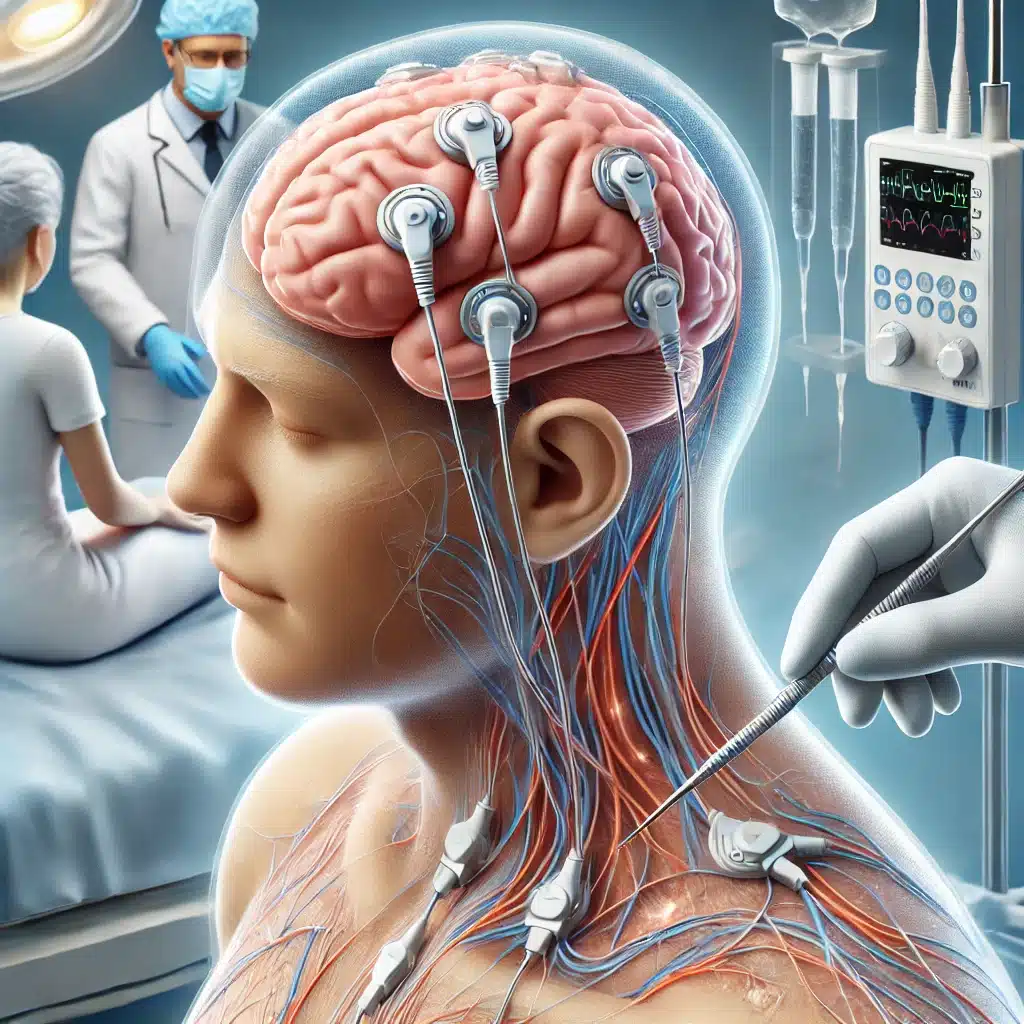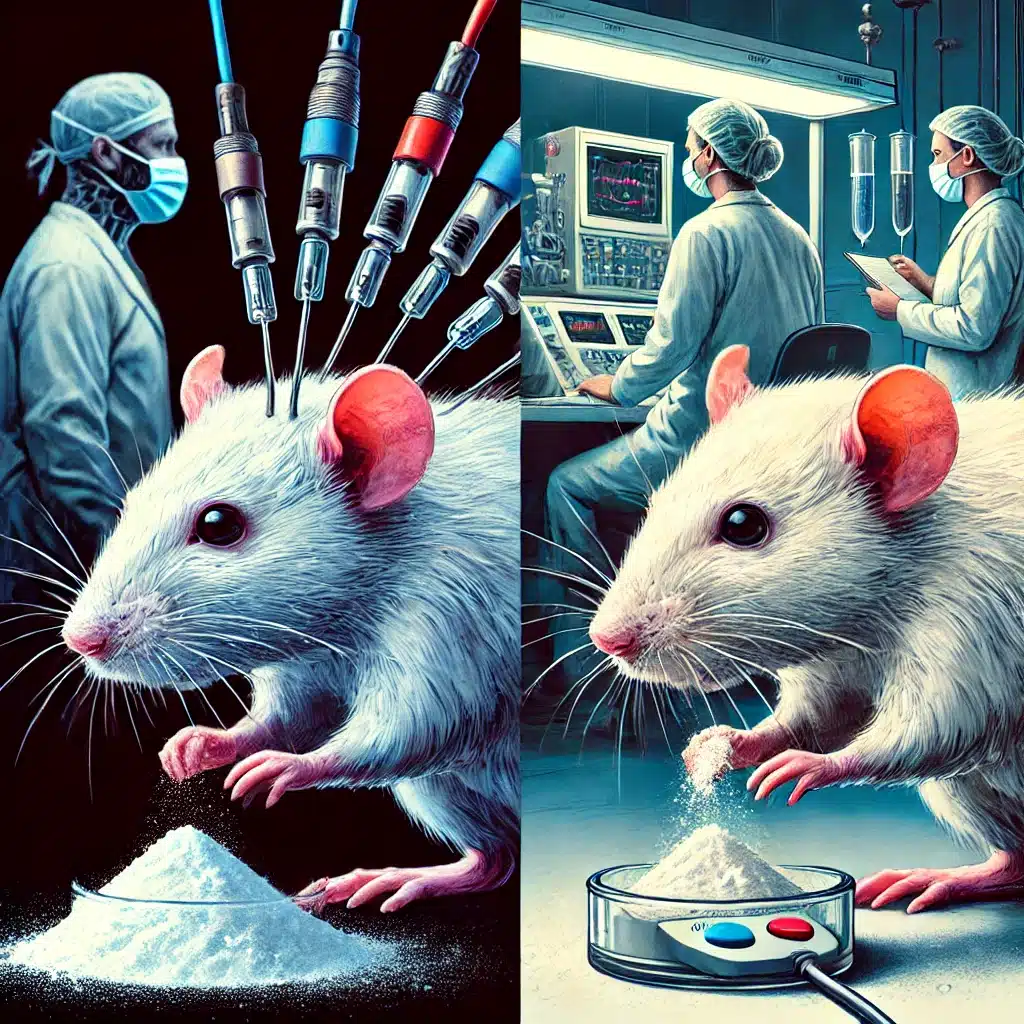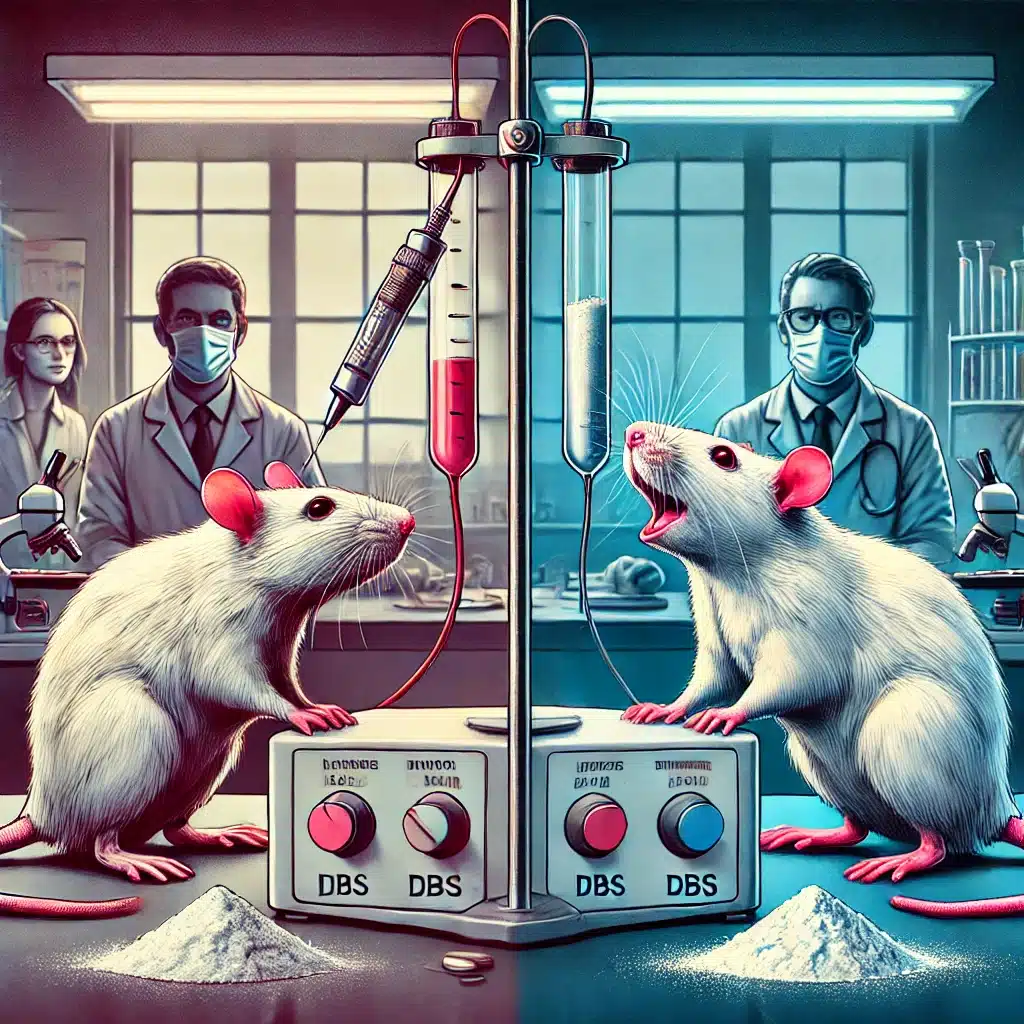Deep brain stimulation (DBS) in the nucleus accumbens reduces cocaine seeking in male rats but is ineffective in female rats, regardless of their estrous cycle phase.
Highlights:
- No FDA-Approved Treatments: There are currently no FDA-approved treatments for cocaine use disorder.
- DBS Reduces Cocaine Seeking in Males: Previous studies and the current experiment show that DBS of the nucleus accumbens shell significantly reduces cocaine-seeking behavior in male rats.
- DBS Ineffective in Females: In sharp contrast, DBS does not reduce cocaine-seeking behavior in female rats, regardless of whether they are in the estrus or non-estrus phase of their cycle.
- Sex Differences in DBS Efficacy: The ineffectiveness of DBS in female rats suggests a significant sex difference in how this treatment affects cocaine-seeking behavior.
- Implications for Human Treatment: These results highlight the need for clinical studies to explore the efficacy of DBS for cocaine use disorder specifically in women.
Source: Neuroscience Letters (2024)
Major Findings: Deep Brain Stimulation (DBS) of Nucleus Accumbens vs. Cocaine Seeking in Rats (2024)
1. Lack of FDA-Approved Treatments for Cocaine Addiction
Current Status: Cocaine use disorder (CUD) is a significant public health issue with no FDA-approved pharmacological treatments. This lack of approved treatments represents a critical gap in the medical management of cocaine addiction.
Impact: Without FDA-approved medications, individuals with CUD rely on behavioral therapies, which may not be sufficient for all patients. This gap underscores the urgent need for new therapeutic strategies to support those struggling with cocaine addiction.
2. DBS Reduces Cocaine Seeking in Male Rats
Key Finding: Deep Brain Stimulation (DBS) of the nucleus accumbens shell has been found to significantly reduce cocaine-seeking behavior in male rats.
Outcome: When DBS was applied, male rats exhibited a notable decrease in the urge to seek cocaine compared to periods without stimulation.
Method: The study involved male rats that were allowed to self-administer cocaine until they developed a habitual drug-seeking behavior.
DBS Application: After establishing this behavior, researchers administered a small, priming dose of cocaine to induce craving. During this phase, DBS was applied to the nucleus accumbens shell.
Results: The male rats displayed significantly reduced drug-seeking behavior during DBS sessions, demonstrating the potential effectiveness of this intervention in disrupting the cycle of craving and relapse.
3. DBS Ineffective in Female Rats
Key Finding: In stark contrast to the results observed in male rats, DBS did not reduce cocaine-seeking behavior in female rats.
Consistency Across Phases: This ineffectiveness was observed regardless of whether the female rats were in the estrus phase (characterized by high estrogen levels) or non-estrus phases (lower estrogen levels).
Hormonal Influence: The consistent lack of effect across different phases of the estrous cycle suggests that hormonal fluctuations do not account for the ineffectiveness of DBS in female rats.
Broader Implications: These results indicate that the underlying mechanisms of addiction and the response to DBS are fundamentally different between sexes.
4. Significant Sex Differences in DBS Efficacy
Observation: The study highlights a clear sex difference in the efficacy of DBS, with male rats benefiting from the treatment while female rats do not.
Underlying Mechanisms: These differences may be due to variations in brain structure, neuronal excitability, and hormonal influences between males and females.
Treatment Approaches: The findings suggest that treatments for cocaine addiction may need to be tailored specifically for men and women, taking into account their unique biological and hormonal profiles.
Research Needs: There is a critical need for further research to understand the sex-specific mechanisms at play and to develop effective, gender-specific treatment protocols.
5. Need for Clinical Studies in Women
Clinical Trials: Given the ineffectiveness of DBS in female rats, it is crucial to conduct clinical studies to determine whether DBS could be a viable treatment option for cocaine use disorder in women.
Sex Differences: Future studies should be designed to specifically explore potential sex differences in the response to DBS and other treatments.
Inclusion of Women: Historically, most addiction research and clinical trials have focused on men, resulting in a significant knowledge gap regarding the treatment of women with cocaine use disorder.
Comprehensive Approach: Addressing these gaps will require a concerted effort to include women in research studies, ensuring that findings are applicable to both sexes and that women receive the most effective treatments based on robust scientific evidence.
How DBS Works in Humans

Deep Brain Stimulation (DBS) involves the surgical implantation of electrodes in specific brain regions.
These electrodes deliver controlled electrical impulses to modulate abnormal neural activity.
The electrical impulses can either excite or inhibit neuronal activity, helping to restore normal function in the targeted brain area.
DBS is typically controlled by a pacemaker-like device implanted under the skin in the chest, which is connected to the electrodes via a wire.
Current Use of DBS in Humans
DBS is a well-established treatment for several neurological and psychiatric conditions.
It is most commonly used for:
- Parkinson’s Disease: DBS helps manage motor symptoms such as tremors, stiffness, and dyskinesia.
- Essential Tremor: DBS can significantly reduce tremors in patients unresponsive to medication.
- Dystonia: DBS is used to alleviate muscle contractions and abnormal postures.
- Epilepsy: In some cases, DBS helps reduce the frequency and severity of seizures.
- Obsessive-Compulsive Disorder (OCD): DBS can be effective for patients with severe, treatment-resistant OCD.
- Treatment-Resistant Depression: Some patients with severe depression unresponsive to other treatments may benefit from DBS.
Potential Use of DBS for Addictions
While DBS is not yet a standard treatment for addiction, research is increasingly exploring its potential in this area.
Studies have shown promising results in preclinical trials (like the one discussed here) and early-stage clinical trials for substance use disorders.
Key considerations for the future use of DBS for addiction include:
- Mechanism: Understanding how DBS modulates brain circuits involved in reward, craving, and impulse control is crucial.
- Safety and Efficacy: Ongoing research aims to establish the safety and long-term efficacy of DBS for addiction, determining the optimal brain targets and stimulation parameters.
- Personalization: Given the sex differences observed in preclinical studies, personalized approaches to DBS for addiction may be necessary to ensure effectiveness across different populations.
Potential Translation: DBS for Cocaine Use Disorder in Humans
Sex-Specific Treatments
The significant difference in DBS efficacy between male and female rats suggests that treatments for cocaine use disorder may need to be sex-specific.
This could lead to the development of tailored DBS protocols or other interventions that consider gender differences in brain responses to treatment.
Need for Clinical Trials
To confirm the findings in rats, clinical trials in humans, specifically including women, are essential.
These studies would help determine if DBS could be an effective treatment for cocaine use disorder in humans and whether sex-specific approaches are necessary.
Targets of Interest Within the Brain for Addictions
Nucleus Accumbens
- Function: Critical in the brain’s reward circuitry, influencing motivation and pleasure.
- DBS Application: Shown to reduce cocaine-seeking behavior in male rats and is a promising target for reducing drug cravings and relapse.
Prefrontal Cortex
- Function: Involved in decision-making, impulse control, and regulation of emotional responses.
- Potential Target: Dysfunction in this area is linked to addiction-related behaviors. Modulating its activity through DBS or other methods could help restore control over drug-seeking behaviors.
Ventral Tegmental Area (VTA)
- Function: Plays a key role in the release of dopamine, a neurotransmitter involved in the reward system.
- DBS Potential: Targeting the VTA may help reduce the reinforcing effects of drugs and decrease cravings.
Amygdala
- Function: Involved in emotional processing and has a role in stress-induced relapse.
- Research Interest: Modulating the activity of the amygdala could help manage anxiety and stress-related triggers for relapse.
Hippocampus
- Function: Associated with memory and learning, including the formation of drug-related memories.
- Therapeutic Potential: Altering hippocampal activity may help disrupt the memories associated with drug use, reducing the likelihood of relapse.
Current Research
- Personalized Medicine: Ongoing research aims to understand individual differences in brain structure and function that contribute to addiction, paving the way for personalized treatment strategies.
- Combination Therapies: Combining DBS with behavioral therapies, pharmacological treatments, or other neuromodulation techniques may enhance overall treatment efficacy.
- Non-Invasive Techniques: Exploring non-invasive brain stimulation methods, such as transcranial magnetic stimulation (TMS), offers potential alternatives to DBS with fewer risks.
Study Overview: Deep Brain Stimulation & Cocaine Addiction in Rats (2024)

The aim of this study was to evaluate the effectiveness of Deep Brain Stimulation (DBS) in reducing cocaine-seeking behavior in female rats and compare it to male rats, considering different phases of the estrous cycle in females.
Sample
- Male Rats: Adult male Sprague Dawley rats.
- Female Rats: Adult female Sprague Dawley rats, evaluated in both estrus and non-estrus phases.
Methods
- Cocaine Self-Administration: Rats self-administered cocaine for 21 days, followed by extinction sessions where cocaine was replaced with saline until their cocaine-seeking behavior was reduced.
- Reinstatement Testing: After extinction, rats received a priming dose of cocaine to trigger drug-seeking behavior. During these sessions, rats received either DBS or sham stimulation.
- DBS Application: DBS was applied to the nucleus accumbens shell during reinstatement sessions at specific electrical parameters (150 µA, 160 Hz).
- Estrous Cycle Monitoring: Female rats were monitored for their estrous cycle phase through vaginal swabbing to determine whether they were in estrus or non-estrus phases during testing.
Limitations
- Sex-Specific Responses: The study found a significant difference in the response to DBS between male and female rats, suggesting sex-specific mechanisms that were not fully explored.
- Estrous Cycle Considerations: While the study accounted for the estrous cycle phases in female rats, it did not differentiate between all non-estrus phases (metestrus, diestrus, proestrus), potentially missing nuanced effects.
- DBS Parameters: The study used a fixed set of DBS parameters, which may not have been optimized for female rats.
- Translation to Humans: Findings in rats may not directly translate to humans, and clinical studies are needed to confirm these results in people with cocaine use disorder.
Conclusion: DBS for Cocaine Addictions
This study highlights a significant sex difference in the efficacy of Deep Brain Stimulation (DBS) for reducing cocaine-seeking behavior, with positive results in male rats but no effect in female rats, regardless of their estrous cycle phase.
These findings suggest that treatments for cocaine use disorder may need to be tailored specifically for men and women, acknowledging the unique biological and hormonal influences in each sex.
The ineffectiveness of DBS in female rats underscores the importance of including both sexes in preclinical and clinical research to develop effective treatments for everyone.
Future clinical trials are necessary to determine whether these sex-specific differences observed in rats translate to humans.
By exploring personalized approaches and targeting key brain regions involved in addiction, this research paves the way for more effective and inclusive treatment strategies for cocaine use disorder.
References
- Study: Differential effects of deep brain stimulation on reinstatement of cocaine seeking in male and female rats (2024)
- Authors: Sharvari Mankame et al.







